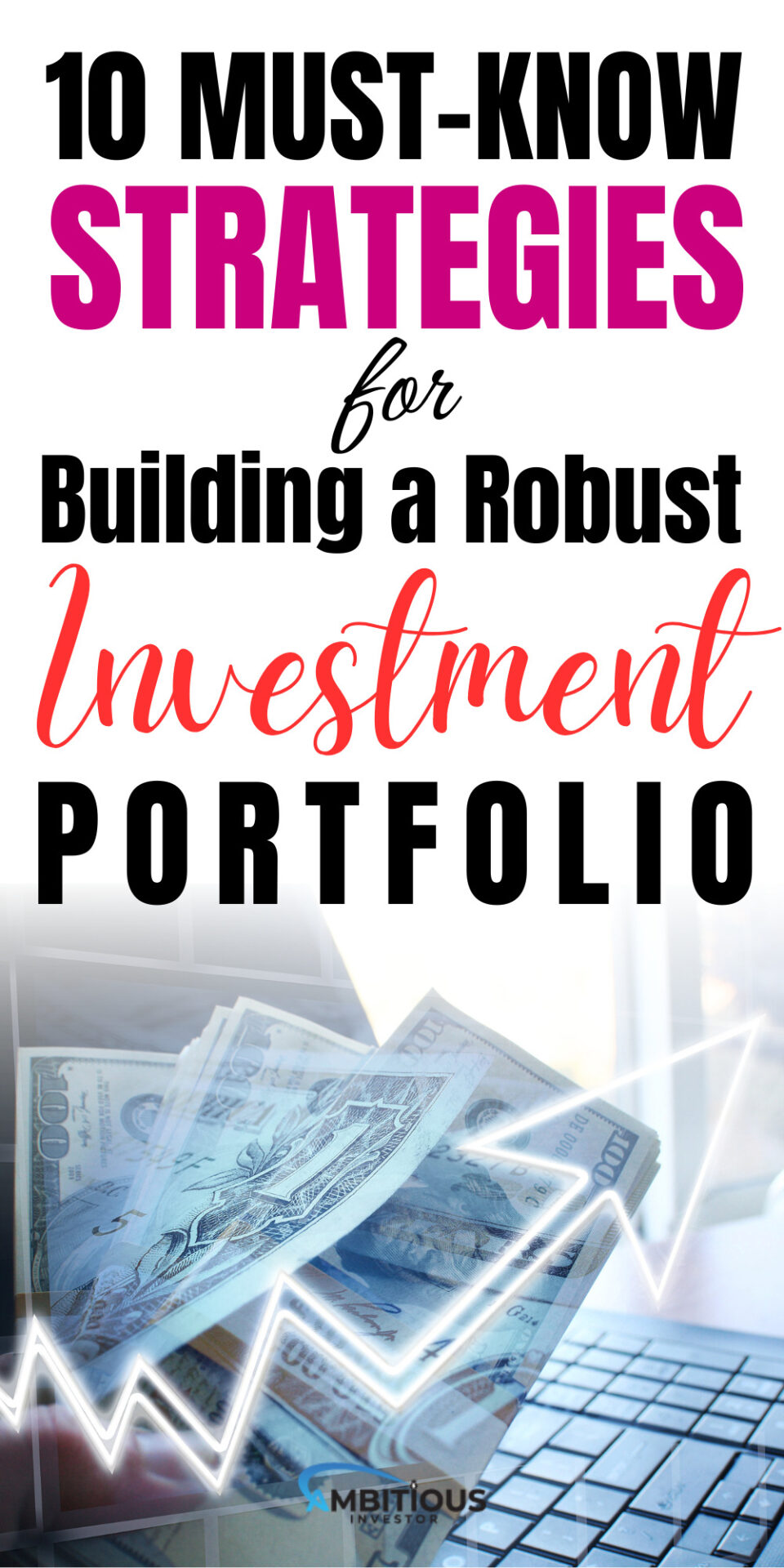10 Must-Know Strategies for Building a Robust Investment Portfolio
Investing your money is a smart way to grow your wealth, but it can be overwhelming if you don’t know where to start. There are many ways you can invest your money and not everyone is financially savvy. Sometimes it can feel overwhelming to plan a financial future for yourself and your family, but with expert advice, it doesn’t have to be. Building a robust investment portfolio requires a solid plan, patience, and discipline.
If you spend the time to put in a lot of financial research and planning into building an investment portfolio, you will have a lot of weight off your shoulders in the future regarding your financial security. This article will cover ten must-know strategies for building a robust investment portfolio.
Introduction to Building a robust investment portfolio
Before diving into the strategies, let’s define a robust investment portfolio. A robust investment portfolio is a diversified investment portfolio that is designed to achieve your financial goals while minimizing risk. The key to building a robust investment portfolio is to create a well-balanced mix of investments that align with your investment goals, time horizon, and risk tolerance. We have all heard the age-old phrase “do not put your eggs all in one basket”; that is exactly the idea behind a robust investment strategy.
Defining a robust investment portfolio
To define a robust investment portfolio, let’s start with the basics. A robust investment portfolio is a collection of investments that are designed to achieve your financial goals while minimizing risk. There are many types of investments, such as stocks, bonds, mutual funds, exchange-traded funds (ETFs), and real estate. A robust investment portfolio should be diversified across different asset classes to spread the risk and reduce volatility. By having more diversification in your investment portfolio, you increase your probability of financial success in the future should one of these markets have a downturn.
Setting investment goals for your portfolio
The first step in building a robust investment portfolio is to set your investment goals. Your investment goals should be specific, measurable, achievable, realistic, and time-bound, otherwise known as SMART goals. This will help you pen out all the details of what you want to achieve and how you can take steps to do it within a specified time frame.
For example, your investment goal might be to save $1 million for retirement in 20 years. Once you have set your investment goals, you can create build an investment portfolio and plan that aligns with your goals.
When setting your investment goals, consider your risk tolerance, time horizon, and financial situation. If you have a long time horizon, you may be able to take more risks and invest in higher-risk investments such as stocks. If you have a short window for investments, you may want to invest in some assets with a lower risk such as bonds.
Understanding your risk tolerance
Understanding your risk tolerance is critical when building a robust investment portfolio. If you have a high-risk tolerance, you may be comfortable with higher-risk investments such as stocks or junk bonds (which have a high return but a high risk of default). If you have a low-risk tolerance, you may prefer lower-risk investments in fixed-income securities such as bonds.
Understanding your risk tolerance is essential because it will impact your investment decisions. Investing in high-risk investments with a low-risk tolerance can lead to anxiety and stress. Conversely, investing in low-risk investments when you have a high-risk tolerance can result in missed opportunities for growth. Consider your current financial situation when determining what kind of investment risk you want to take.
Diversifying your investments
Diversification is a crucial strategy when building a robust investment portfolio. Diversification in investment management helps to reduce risk by spreading your investments across different types of investments that behave differently in different market conditions.
For example, if you invest all your money in one stock, you are taking on a lot of risk. However, if you diversify your investments across different stocks, bonds, and real estate, you are spreading your risk and reducing the impact of any single investment on your portfolio. Having more diversity in your investment portfolio will ensure that you have a successful financial future.
Investing in different asset classes
Investing in different asset classes is another critical strategy for building a robust investment portfolio. This will help you achieve long-term financial success and provide different rates of return and risk. Different asset classes behave differently in different market conditions, so investing in a mix of these asset class classes can help to reduce risk and increase returns.
For example, stocks tend to perform well in a growing economy, while bonds tend to perform well in a declining economy. Real estate can provide consistent income through rental payments and fixed income, and can appreciate in value over time. By investing in a mix of asset classes, you are spreading your risk and taking advantage of different market conditions.
Choosing the right investment vehicles
Choosing the right investment vehicles is another critical strategy for building a robust investment portfolio. Each investment vehicle has its own advantages and disadvantages, so it’s essential to choose the right investment vehicle for your needs. Make sure to research each type of investment vehicle to fully understand the impact of the market on your investment.
When choosing the right investment portfolio for vehicles, consider your investment goals, risk tolerance, and time horizon. You may be comfortable with higher-risk investments such as stocks if you have a long time horizon.
Should you include cryptocurrency in your investment portfolio?
In the recent modern age, many investors have decided to participate in the cryptocurrency market. This is still a very new market with strongly held polarized views from investors: they either love it or hate it. You have likely heard cryptocurrency being discussed by those in your social circles, but may not be sure if it is a good idea to invest in. There are many currency options in this market, the most successful and well-known being Bitcoin.
If you are very knowledgeable about cryptocurrency and feel confident investing in it, include it in your investment portfolio. If you don’t know where to start with cryptocurrency and would like to include it in your robust portfolio, please make sure to do ample research, consult experts, and do not make it a large percentage of your overall investment portfolio.
There is a high risk of default and return in this market. While there are many legitimate currencies, there are also many scam currencies trying to take advantage of eager or uneducated investors.
Regularly monitoring and rebalancing your portfolio
Regularly monitoring and rebalancing your portfolio is essential for maintaining a robust investment portfolio. Market conditions and your personal situation can change over time, so reviewing and adjusting your portfolio regularly is essential.
For example, if you have a target allocation of 60% stocks and 40% bonds, but stocks have performed well and now make up 70% of your portfolio. If that is the case for your portfolio, you will want to sell off some stock and buy more bonds to rebalance your investments. Rebalancing helps to maintain your target allocation and reduce risk.
If you do not have adequate time to monitor and rebalance your robust investment portfolio, you may wish to seek out the advice of a financial advisor. They can ensure that your finances are handled appropriately and watch your investments for you.
Seeking professional advice on building a robust portfolio
Building a robust investment portfolio can be challenging, and it can be helpful to seek professional advice. A financial advisor can help you define your investment goals, understand your risk tolerance, and create a well-balanced investment portfolio that aligns with your needs.
When choosing a financial advisor, look for someone who is a fiduciary, which means they are legally obligated to act in your best interests. Ask about their experience and credentials and ensure you feel comfortable working with them.
Having a financial advisor that will monitor and help with your investment portfolio long term will help you achieve the best success in your financial goals. They have the industry know-how and expertise that will help you make the right decisions and take a lot of stress off your shoulders.
Conclusion
Building a robust investment portfolio requires a solid plan, patience, and discipline. To build a robust investment portfolio, you should define your investment goals, understand your risk tolerance, diversify your investments, invest in different asset classes, choose the right investment vehicles, regularly monitor and move investment portfolios, rebalance your portfolio, and seek professional advice.
Additionally, most investors and financial advisors will tell you, its not about ‘timing the market, it is about ‘time in the market’ so try to invest into your portfolio to see growth consistently.
Remember that financial investment does not have a guarantee as it involves risk. However, by following these strategies, you can build a well-balanced investment portfolio that aligns with your needs and helps you achieve your financial goals.
Bottomline
Start building a robust investment portfolio today by defining your investment goals and understanding your risk tolerance. Check out the best investment apps blog post to learn more about online brokerage and mutual fund platforms. Consider seeking professional advice to create a well-balanced investment portfolio that aligns with your needs.










